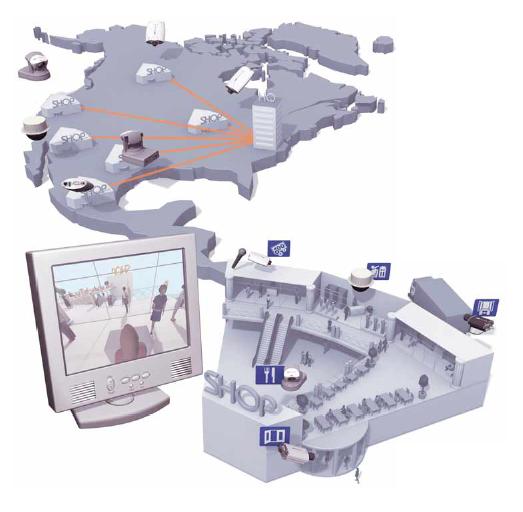 Network
Video Solution
Network
Video Solution
Market Segments - Retail

Network
video is used for security and remote monitoring purposes helping
to keep store owners better informed, prevent theft and making
store management more efficient. The diagram shows a chain of
stores scattered about the country with the company headquarters
situated in the capital city. Images from the branch outlets can
be accessed from the headquarters at any time over the IP network.
Entrance
and Exit
Cameras placed at the entrance and exit to the store record who
comes in and out 24 hours per day. This footage can be used to
identify shoplifters, and make sure employees are in place during
the correct times. Cameras fitted with motion detection can be
employed out of business hours to register an alarm in the event
of a break-in. If an alarm sounds, security staff can immediately
view the images remotely to see whether or not their presence
is required íV a high percentage of alarms today are actually
false.
Cash
Desk
Cameras placed at the cash desk deter thieves, provide evidence
in the case of theft and at the same time can be used to ensure
that staff are following the correct sales routines. Electronic
cash registers integrated with network video systems at the point
of sales ensure that every transaction is monitored and no irregularities
occur.
Changing
Rooms
In a clothes store, shoplifting regularly occurs in the changing
rooms. To deter crime and give staff increased peace of mind,
network cameras can be installed here. Moreover, the staff of
large stores can view changing room images to check if they need
tidying up after customers.
Consumer
Behavior
As successful retailing becomes more and more of a science, large
stores are turning to network camera technology to improve their
knowledge of consumer behavior. With strategically placed cameras,
store managers can observe, record and measure consumer behavior.
The results of their studies can be used, e.g., to analyze the
success of different store layouts.
Quality
of Service
Store managers might also use network cameras to ensure that their
employees are offering customers a sufficiently high quality of
service. Footage of customer interaction can be a useful tool
for demonstrating the "do's and don'ts" in e.g. courtesy
training programs.

